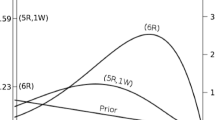Abstract
A simple, stochastic model is developed of an asexual biological population that is undergoing natural selection. It is then observed that the size of the population, like the temperature parameter in the simulated annealing algorithm, is a measure of the amount of randomness to be allowed in the system. Exploiting the formal analogy between the two processes, it is shown that the distribution of different types of organisms in the population model converges to a stationary distribution if the population is growing more slowly thanO(lnt) (“annealing”), but can fail to converge at all if the population is growing faster thanO(lnt) (“quenching”). The results may be related to the “historical accidents” that permeate biological structures.
Similar content being viewed by others
References
S. J. Gould,The Panda's Thumb: More Reflections in Natural History (Norton, New York, 1980).
E. Weinberger, Ph. D. Thesis, Courant Institute of Mathematical Sciences, New York (1987).
M. Eigen and P. Schuster,The Hypercycle: A Principle of Natural Self-Organization (Springer, New York, 1979).
J. Gillespie,Evolution 38(5):1116–1129 (1984).
S. Karlin and H. Taylor,A First Course in Stochastic Processes (Academic Press, New York, 1981).
W. Feller,Introduction to Probability Theory and Its Applications (Wiley, New York, 1968).
S. Karlin and H. Taylor,A Second Course in Stochastic Processes (Academic Press, New York, 1981).
S. Kirkpatrick, C. D. Gelatt, Jr. and M. P. Vecci,Annealing, Science 220:671–680 (1983).
E. H. L. Aarts and P. J. M. van Laarhoven,Philips J. Res. 40:193–226 (1985).
D. Isaacson and R. Madsen,Markov Chains: Theory and Applications (Wiley, and Sons, New York, 1976).
Basilis Gidas,J. Stat. Phys. 39:73–131 (1985).
S. J. Gould,Hen's Teeth and Horses Toes (Norton, New York, 1983).
Author information
Authors and Affiliations
Rights and permissions
About this article
Cite this article
Weinberger, E. A model of natural selection that exhibits a dynamic phase transition. J Stat Phys 49, 1011–1028 (1987). https://doi.org/10.1007/BF01017557
Received:
Revised:
Issue Date:
DOI: https://doi.org/10.1007/BF01017557




